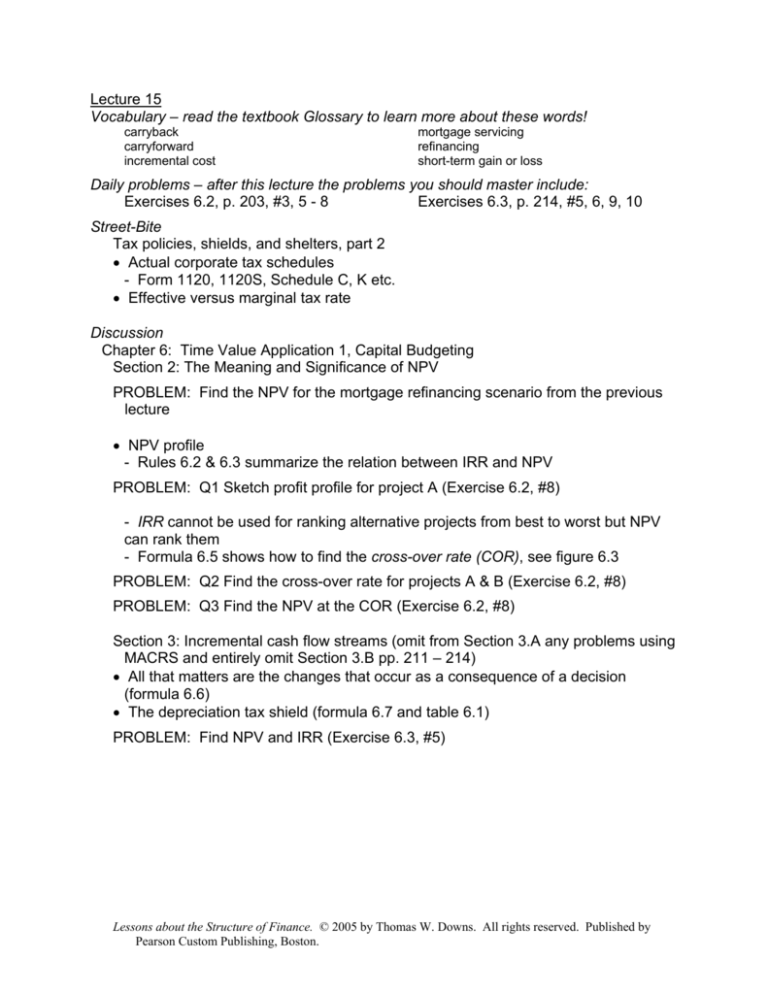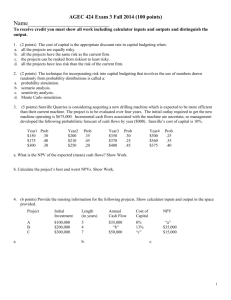
Lecture 15
Vocabulary – read the textbook Glossary to learn more about these words!
carryback
carryforward
incremental cost
mortgage servicing
refinancing
short-term gain or loss
Daily problems – after this lecture the problems you should master include:
Exercises 6.2, p. 203, #3, 5 - 8
Exercises 6.3, p. 214, #5, 6, 9, 10
Street-Bite
Tax policies, shields, and shelters, part 2
• Actual corporate tax schedules
- Form 1120, 1120S, Schedule C, K etc.
• Effective versus marginal tax rate
Discussion
Chapter 6: Time Value Application 1, Capital Budgeting
Section 2: The Meaning and Significance of NPV
PROBLEM: Find the NPV for the mortgage refinancing scenario from the previous
lecture
• NPV profile
- Rules 6.2 & 6.3 summarize the relation between IRR and NPV
PROBLEM: Q1 Sketch profit profile for project A (Exercise 6.2, #8)
- IRR cannot be used for ranking alternative projects from best to worst but NPV
can rank them
- Formula 6.5 shows how to find the cross-over rate (COR), see figure 6.3
PROBLEM: Q2 Find the cross-over rate for projects A & B (Exercise 6.2, #8)
PROBLEM: Q3 Find the NPV at the COR (Exercise 6.2, #8)
Section 3: Incremental cash flow streams (omit from Section 3.A any problems using
MACRS and entirely omit Section 3.B pp. 211 – 214)
• All that matters are the changes that occur as a consequence of a decision
(formula 6.6)
• The depreciation tax shield (formula 6.7 and table 6.1)
PROBLEM: Find NPV and IRR (Exercise 6.3, #5)
Lessons about the Structure of Finance. © 2005 by Thomas W. Downs. All rights reserved. Published by
Pearson Custom Publishing, Boston.
CB3 Mortgage refinancing
You took out a 30-year mortgage (monthly payments) for $140,000 at 9.90% and
payment number 36 is due today. You are deciding whether you should refinance the
outstanding principal by borrowing at today’s lower rate of 8.20% an amount that pays
off the old loan. The new loan is for 30 years as of today. The total fees for getting the
new loan equal 4.4% of the original loan’s outstanding principal. The first payment for
the new loan would be due one month from today. Suppose you pay the fees today
with funds from your savings account.
Q1. How long in months is the payback period?
{ANSWER: 32 months; CLUES: PMTI/Y= 9.9% = $1218; Loan balanceN= 324 =
$137,361; PMTI/Y= 8.2% = $1027; Fees = $6,044; monthly savings = $191}
Q2. How much would you save in interest expense over the life of the loan?
{ANSWER: $24,955 }
Q3. Find the annual IRR.
{ANSWER: a nonsensical -3.22%; CLUES: CF0 = $-6,044; CF1 = $191 for 324 periods;
CF2 = $-1,027 for 36 periods; NOTE that a second IRR exists at about 38.0%}
Q4. Suppose that your personal discount rate is 10%. Find the net present value to
you of the refinancing decision.
{ANSWER: $13,155; CLUES: CF0 = $-6,044; CF1 = $191 for 324 periods; CF2 = $1,027 for 36 periods}
EXAMPLE 6 Simplest NPV
Reconsider the project that costs $3,000 and returns after-tax cash flow of $1,000 per
year for 5 years. What is the project’s NPV if the financing rate is 9.5% compounded
annually?
SOLUTION
The following equation depicts the NPV computation
NPV =
$1,000
$1,000
$1, 000
$1,000
$1,000
+
+
+
+
− $3,000
1
2
3
4
(1 + .095)
(1+ .095)
(1 + .095)
(1+ .095) (1 + .095) 5
= $3,839.71 − $3000
.
= $839.71
Lessons about the Structure of Finance. © 2005 by Thomas W. Downs. All rights reserved. Published by Pearson
Custom Publishing, Boston.
The NPV is a positive number. Thus, this project creates economic profit and is a
feasible choice for the company.
Section 2.A. NPV represents economic profit
The following illustrates wealth creation by a positive NPV investment. Recall the
example above when an investment costs $3,000 and returns after-tax cash flow of
$1,000 per year for 5 years. With a financing rate of 9.5% the NPV is $839.71.
Suppose the entrepreneur finances the entire $3,000 cost of the project, and also
borrows an additional $839.71. The total loan amount, that is the source of financing,
therefore equals $3,839.71. The entrepreneur uses the funds as follows:
total financing
$3,839.71
/
$3,000
buy project
\
$839.71
put in pocket
The entrepreneur pays $3,000 to the vendor in order to purchase the investment. The
remainder of the money is “pocketed.” Perhaps the money is held in a company cash
account, perhaps it is paid-out as a dividend to shareholders or as a Christmas bonus to
employees, etc. The important point is that the company has this extra money to use as
it sees fit. The extra money equals NPV and represents economic profit.
Suppose the lender agrees to accept loan payments equal to the amount of the
project cash flows. On all outstanding principal, however, the entrepreneur must pay
9.5 percent interest. The table below illustrates amortization mechanics for this loan.
year
1
2
3
4
5
beginning-ofyear
outstanding
principal
$3,839.71
$3,204.48
$2,508.91
$1,747.25
$913.24
end-of-year
principal &
accumulated
interest
$4,204.48
$3,508.91
$2,747.25
$1,913.24
$1,000.00
project cash
flow & loan
payment
end-of-year
outstanding
principal
$1,000
$1,000
$1,000
$1,000
$1,000
$3,204.48
$2,508.91
$1,747.25
$913.24
$0.00
The project cash flows completely repay the loan. The loan is larger than the project
cost, however. The economic profit equals the difference between the loan amount
($3,839.71) and project cost ($3,000). The investment’s net present value of $839.71 is
economic profit. For the scenario illustrated above, the company receives the new
wealth up-front by borrowing more than the investment cost. The company is said to
“capitalize” the economic profit. Alternatively, if the company borrows a lesser amount,
Lessons about the Structure of Finance. © 2005 by Thomas W. Downs. All rights reserved. Published by Pearson
Custom Publishing, Boston.
say just enough (or less) to pay for the investment, then project cash flows would
exceed the loan payments. The economic profit accrues in the future and the company
is said to “amortize” the wealth. Regardless of whether the company amortizes or
capitalizes the wealth, undertaking positive NPV investments creates wealth.
RULE 6.2 Identity between NPV and IRR
The IRR for a project is the financing rate at which the project’s NPV is zero.
EXERCISES 6.2
8. Consider the following cash flows for two mutually exclusive investments:
t=0
($620)
($760)
A
B
t=1
$457
$88
t=2
$280
$255
t=3
$115
$768
PROBLEM: Q1 Sketch profit profile for project A (Exercise 6.2, #8)
PROBLEM: Q2 Which is best, A or B? Find the cross-over rate for projects A & B
(Exercise 6.2, #8)
The cross-over point occurs when the NPV of the two projects are equal. The
financing rate at the cross-over point is called the cross-over rate “COR”. Use formula
6.4 to set the NPV of two projects, call them A and B, equal to each other. Then
rearrange to obtain the following formula for finding the COR.
FORMULA 6.5 The cross-over financing rate “COR”
CFtinflowsfor A −CFtinflowsforB
.
cost −cost =∑
(1 + COR )t
t =0
A
B
N
PROBLEM: Q3 Find the NPV at the COR (Exercise 6.2, #8)
Lessons about the Structure of Finance. © 2005 by Thomas W. Downs. All rights reserved. Published by Pearson
Custom Publishing, Boston.
NP V
NP V
A
B
NP V
C
D
E
F
FIGURE 6.3 Potential configurations for cross-over points
FORMULA 6.6 Incremental cash flows, general version
∆CFt = change in cash flow resulting from a decision
= CFt new situation − CFt old situation
.
FORMULA 6.7 Incremental cash flow from assets, concise version
∆CF = (∆EBITDA)x(1- tax rate) + (tax rate)x(∆depreciation deduction),
where EBITDA equals "earnings before interest, taxes, depreciation and amortization"
(that is, sales minus variable costs, which is the same as sales minus cost-of-goods
sold minus selling, general, and administrative expenses; see the discussion following
formula 3.9.).
Lessons about the Structure of Finance. © 2005 by Thomas W. Downs. All rights reserved. Published by Pearson
Custom Publishing, Boston.
EXERCISES 6.3
5. The company invests $70,000 in an asset that should increase pre-tax revenue by
$15,400 per year perpetually. The asset is depreciated for tax purposes by straight-line
over 5 years. If the company faces a 30% tax rate and 13.9% financing rate, what is the
investment’s Net Present Value?
CB10a IRR&NPV w/ straight-line, no salvage value, 3-year stream
Your company is analyzing purchase of a machine costing $6,000 today. The
investment promises to add $7,500 to sales one year from today, $10,500 two years
from today, and $14,000 three years from today. Incremental cash costs should
consume 65% of the incremental sales. The tax rate is 30% and the company’s
financing rate is 12.8%. The investment cost is depreciated to zero over a 3-year
straight-line schedule. Find the project’s net present value and internal rate of return.
{ANSWER: NPV and IRR equal $1,462 and 25.5% CLUES: Incremental CF for years
1-3 = $2,438 $3,173 $4,030 }
Lessons about the Structure of Finance. © 2005 by Thomas W. Downs. All rights reserved. Published by Pearson
Custom Publishing, Boston.










